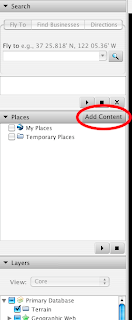Posted by Matt Manolides, GIS Specialist
Great job, everyone! I love following your collective blog entries tracking the updates, especially the ones that find updated imagery totally unrelated to the hints I gave.
Answers:
1) U.S. Route 91 turns into a much more famous stretch of road when it crosses into this town.
-- Las Vegas (The Las Vegas Strip)

2) Every year, this city plays host to the U.K.'s largest outdoor (temporary) ice rink.
--
Leeds, England (The Ice Cube)3) Paradise: In this town you can surf or visit the world's most delicious book store, located in
an old Twinkie factory (with plenty of aging filling still in the pipes).
-- Cleveland (Anyone who watches "Anthony Bourdain: No Reservations" should have gotten that one right!)4) The original name of this city was Terminus.
--
Atlanta, Georgia
5) The world's northernmost opera house is located in this town.
-- Umeå, Sweden6) This major U.S. city is actually north of Canada.
-- Detroit, Michigan7) A popular children's game show that promoted geographic knowledge was produced out of
this city.
-- Pittsburgh (Where in the World is Carmen Sandiego?)
8) Don't let the name fool you -- this lake actually fills a 4,000ft deep caldera.
-- Crater Lake, Oregon9) You can tour the Royal Navy's first iron-hulled, armor-plated warship in this town.
-- Portsmouth, England (HMS Warrior)

10) The historic fort in this city was restored based on an 1847 map published in Darmstadt,
Germany.
-- Sacramento (Sutter's Fort)

11) As Halloween approaches, one might be interested in viewing the 'Ghost Capital of Britain.'
-- Derby, England
12) Now part of Germany, this city was once the capital of the Hanseatic League.
-- Luebeck, Germany13) President Lincoln attended the dedication ceremony of the Soldier's National Cemetery in
this town.
-- Gettysburg, PA (President Lincoln gave the Gettysburg Address at this dedication ceremony.)

Here's a more complete list of imagery updates in this data push:New high resolution: Americas: State of Oregon, State of Nebraska, State of North Carolina,
Western Mississippi, Much of Pennsylvania, Yakima County (WA),
Benton County (WA), Whistler (BC), San Jose (CA), Imperial County (CA),
Steamboat Springs (CO), Calhoun County (FL), Adams County (IL),
Washtenaw County (MI), Chemung County (NY), Cortland County (NY),
Castilla (Colombia)
Europe, Middle East & Africa:
- France: French Riviera, Avignon
- UK: Exeter, Brighton, Crawley, Essex, Colchester, Chelmsford,
Swindon, Cheltenham, Ipswich, Norwich, Peterborough, Leicester,
Chesterfield
- Germany: Freiburg, Stuttgart, Waiblingen, Remseck, Kornwestheim,
Ludwigsburg, Saarbruecken, Chemnitz, Erfurt, Ratigen,
Munster, Hamburg, Luebeck
Umea (Sweden)
Borger-Odoorn (The Netherlands)
2.5m imagery for the entire countries of: Tunisia, UAE, Jordan, Syria, Lebanon, and Israel.
Updated Imagery:
Americas: Las Vegas (NV), San Francisco Bay Area (East Bay & North Bay),
Sacramento (CA), Victoria (BC), Salt Lake City (UT), Provo (UT), Edmonton (Alberta),
Atlanta (GA), Northern St Louis (MO), Detroit (MI), Cleveland (OH), Pittsburgh (PA),
Boston (MA), Montreal (Quebec), Guadalajara (MX), Buenos Aires (Argentina),
Belo Horizonte (Brazil), Fortaleza (Brazil), Montevideo (Uruguay)
Europe, Middle East & Africa:
- UK: Plymouth, Torquay, Bournemouth, Southampton, Portsmouth, Gillingham
Southend, Basildon, Berkshire, Reading, Milton Keynes, Newport, Cardiff,
Swansea, Cambridge, Norfolk, Derby, Halifax, Leeds, Darlington, Dundee,
Belfast
Warsaw (Poland), Stockholm (Sweden), Lippstadt (Germany), Magdeburg (Germany),
Paderborn (Germany), Rostock (Germany), Boeblingen (Germany), Casablanca (Morocco),
Bamako (Mali), Windhoek (Namibia), Ankara (Turkey), Kano (Nigeria)
Asia & Oceania: Novosibirsk (Russia), Tashkent (Uzbekistan), Ahmendabad (India),
Pune (India), Bangalore (India), Hyderabad (India), Perth (Australia), Brisbane (Australia)
Ulan Bator (Mongolia),
Updated Terrain:Canada (20m and 90m) and Niagara Falls




































